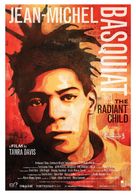Reviews provided by RottenTomatoes
Sebastian Smee, Boston Globe: The intimate, home video footage -- which has never been shown -- feels poignant, a throwback to Basquiat's early days on the New York scene when he got by on his good looks, an elusive inner confidence, and the generosity of others. Read more
Gale Robinson, Dallas Morning News: While it is wonderful to see so many Basquiat paintings, at the film's end the viewer is left feeling complicit in the exploitation. Read more
Kevin Thomas, Los Angeles Times: Jean-Michel Basquiat: The Radiant Child is a remarkably rich documentary possessing depth, range, insight and compassion. Read more
Stephen Holden, New York Times: If The Radiant Child embellishes the legend in a hundred small ways, its cleverest maneuver is to keep its subject at enough of a remove to enhance his mystique. Read more
Carrie Rickey, Philadelphia Inquirer: A touching portrait that may not be the last word on the painter, but has facts and context to burn. Read more
Kenneth Baker, San Francisco Chronicle: [Davis] underplays the place of drugs in the downtown club scene, treating the artist's heroin use as a nearly unaccountable late affliction. Read more
Colin Covert, Minneapolis Star Tribune: In the end the art must speak for the artist; Davis wisely stands aside and lets the magical images tell their tales. Read more
Rick Groen, Globe and Mail: Tamra Davis's documentary does serve as a worthy companion to Julian Schnabel's 1996 biopic. Read more
Joshua Rothkopf, Time Out: The legend of the artist's meteoric rise and fall (to heroin) is so widely known -- and already dramatized via Julian Schnabel's fine biopic, Basquiat -- that Davis is smart to go as personal as she can. Read more
Robert Koehler, Variety: Tamra Davis' labor of love... is a tender ode from one friend to another, but it's also another wheel in the hype machine that persists around the late, famed painter who blew apart the art scene in the 1980s. Read more
Melissa Anderson, Village Voice: [Davis'] homage -- tender, never hagiographic -- also contains some biting analysis of the racism, both overt and insidious, that the artist was up against. Read more
Michael O'Sullivan, Washington Post: Read more

